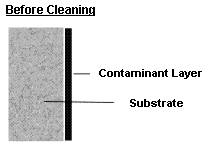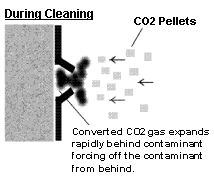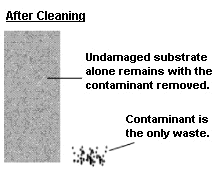Dry Ice Blasting for Electric Motor Repair
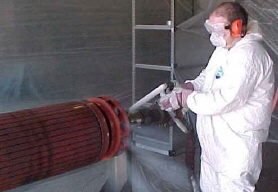
Dry ice blasting (CO2) for electric motor repair shops is preferred due to strict California environmental regulations concerning industrial hazardous waste disposal. Below is a case study for using dry ice blasting (CO2) for an electric motor rebuilder, compared to conventional methods such as sand blasting.
Visalia Electric Motor Case Study
By Jeffrey Lapointe, president of RSG Technologies, Inc.
"What do you do when you're an electric motor shop in California and you're faced with waste disposal costs of $600 per week and feeling the squeeze from ever-growing environmental regulations?"
Those were two significant questions that Gene Quesnoy, president of Visalia Electric of Visalia, CA needed to address.
Traditional cleaning methods - Cleaning with dry ice blasting - Return on investment - Closing comments on dry ice blasting
Gene rented a dry ice blasting machine and tested it by cleaning a few electric motors. He found that the performance was quite good. The use of dry ice (co2) pellets shot out from a blasting gun at high velocity effectively removed the contaminants from all parts of the motor - stator, rotor, end bells and other parts. It cleaned fast and very thoroughly. But what was most attractive was that after the pellets came in contact with the targeted surface, they sublimated (evaporated). There was nothing remaining to be cleaned up. The soiled materials on the motor had fallen to the floor and need to be swept up, but that was it.
Mr. Quesnoy initially investigated dry ice blasting technology for use in field work. If this cleaning method effectively cleaned faster, as thoroughly or more thoroughly than his traditional methods and could reduce his waste disposal costs, he felt he would have valuable tool. However, after, viewing the blasting unit clean, he realized it could also be integrated into daily in-house motor cleaning.
As Gene began to further investigate the dry ice blasting technology, he found that there was a wide discrepancy in pricing among manufacturers. The prices ranged from under $10,000 to $24,000 for units that seemed to offer similar results. How could that be?
After having dialogued with Jeffrey Lapointe, president of RSG Technologies, Inc. The main agent for the Icesonic brand of dry ice blasting systems, Gene felt comfortable that though he was purchasing a very aggressively priced is-35 -- Icesonic's base model machine, he was buying a well performing system. One that would meet his needs.
traditional cleaning methods
Mr. Quesnoy wanted the is-35 dry ice blasting machine to replace his prior cleaning methods - blasting with walnut shells, sand blasting, and solvents. Each of these methods had serious drawbacks, especially in California's regulation-happy climate. Following is a chart displaying the problems with traditional cleaning methods for electric motors and comparing them to dry ice blasting:
Private blast cleaning comparison chart | |||||
Blasting cleaning technique |
|
|
|
|
|
Dry ice | No | No | No | No | Excellent |
Sand | Yes | Yes | No* | No | Ok |
Glass beads | Yes | Yes | No* | No | Ok |
Walnut shells | Yes | Yes | No* | No | Limited |
Steam | No | No | No | Yes | Poor |
Solvents | Yes | No | Yes | Yes | Limited |
* Each of these blast cleaning materials becomes contaminated upon contact if used to clean hazardous objects. When that happens, these materials are then classified as hazardous waste requiring safe disposal. | |||||
Visalia had typically used walnut shells for cleaning. They were inexpensive to purchase and in large supply in California. However, as the chart above points out, walnut shells become a contaminant in the motor cleaning process. The cost of disposal was averaging $600 per week or over $30,000 per year. Another drawback, they found was grit entrapment of the shells in the rotor. This problem could potentially compromise the performance of the stator. Lastly, walnut shells required extensive clean-up to sweep up -- often an additional hour or two.
Frequently, motors needed to be steam cleaned. The results were fair. It provided a reasonably quick clean. The main drawback, however, was the drying time required was significant. Often, a full day was necessary to wait in order to reassemble.
Another cleaning method used by Visalia was sand blasting. This posed additional concerns. In addition to potential grit entrapment, the possibility of shorting out the core was legitimate. Mr. Quesnoy also worried about environmental issues. The dust cloud created by the sand caused him to seriously wonder if a neighboring business might not issue a complaint to the EPA.
Safety issues were a major threat posed by a few of the traditional cleaning methods used at Visalia electric. Both the extremely strong chemicals used in the solvents they employed plus the dust Generated from sand blasting were always potential worker's comp cases waiting to happen. The need to correctly wear high quality respirators was an absolute requirement. (Top)
cleaning with dry ice blasting
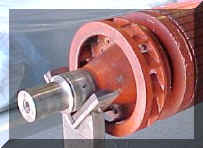
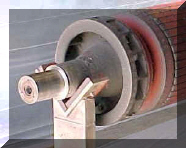
Since Visalia purchased the Icesonic IS-35 in may 2003, they have used it almost daily to clean all of their motors after disassembly. They clean stators, rotors, endbells and all other disassembled parts regardless of the size of the motor. At the time this document was being written, Visalia had an 1100 hp and a 5500 hp motor in the shop for overhaul. They would completely clean the units with the IS-35.
dry ice blasting processStep #1 - energy transfer
Step #2 - micro-thermal shock
Step #3 - gas pressure |
Process illustration:
|
|
|
Visalia found the Icesonic IS-35 easy to operate. To clean a motor, a technician would fill the blaster's hopper with dry ice which amounted to approximately 40 lbs. Setting the pressure to 150 psi, the technician would move the blasting gun from side to side and let the propelled dry ice clean the target area. The surface contaminants impacted by the dib process would then simply fall to the ground. The results included a thorough cleaning of the motor windings, removal of all paint from endbells on metal surfaces that wasn't not firmly adhered. All surfaces would be dry with no component damage.
Gene Quesnoy has been very pleased that the IS-35 has been very easy to operate. Very little training has been required to instruct a new technician on operational procedures. He has few concerns that the operator will damage the motor windings during the process. What he has observed is that a technician will occasionally waste dry ice because of unnecessary over cleaning. He has had to stress that a limited amount of dry ice covering an area is sufficient.
Further, Gene has found that the IS-35 has run trouble free. It has required minimal maintenance. Aside from cleaning the air filter and filling the lubricator after each use, there has been a minimal amount of upkeep. (Top)
return on investment
The purchasing cost of the Icesonic IS-35 was not a decisive factor in the purchasing decision for Mr. Quesnoy. He was confident he could Generate a very fast ROI. Since he was spending approximately $600/week in waste disposal, he was confident that within a year he would get his money back and more so. And then beyond waste disposal savings, he has found opportunity to go on-site to perform motor cleanings during shutdowns. His customers have been very pleased with the results. (Top)
closing comments on dry ice blasting
Gene Quesnoy's only reservation in deciding to purchase the Icesonic IS-35 was that the cost was under $10,000. He questioned whether the performance would be comparable to other more expensive units. To his surprise, he has found that the unit actually performs even better than the higher priced units which he had previously rented. He has been thoroughly satisfied with his purchase.
What he is most pleased with is the great value he's received from the IS-35. He estimates he will be covering his costs within six months of his purchase. In addition, he is addressing the pressing concern of environmental regulations. No longer does he have to worry about possibly being reported for violations from a nearby business. Also, the headaches of compliance to properly dispose of solvents and contaminated sand or walnut shells was significant. And lastly, the ever-possible worker's comp case has been minimized. (Top)
This article donated by https://www.rsg-technologies.com
For an eBook about electric motors, please see "Electric Motor Maintenance And Repairs"

